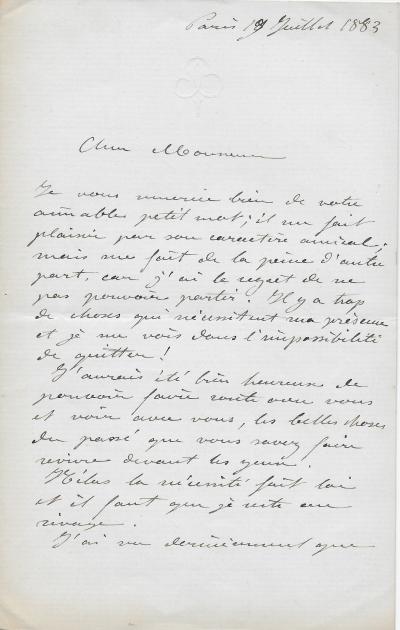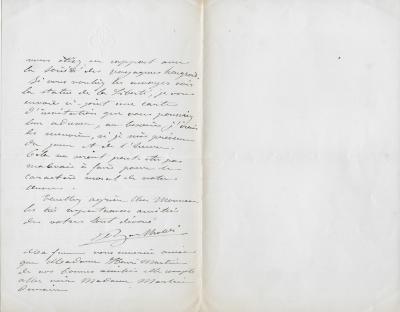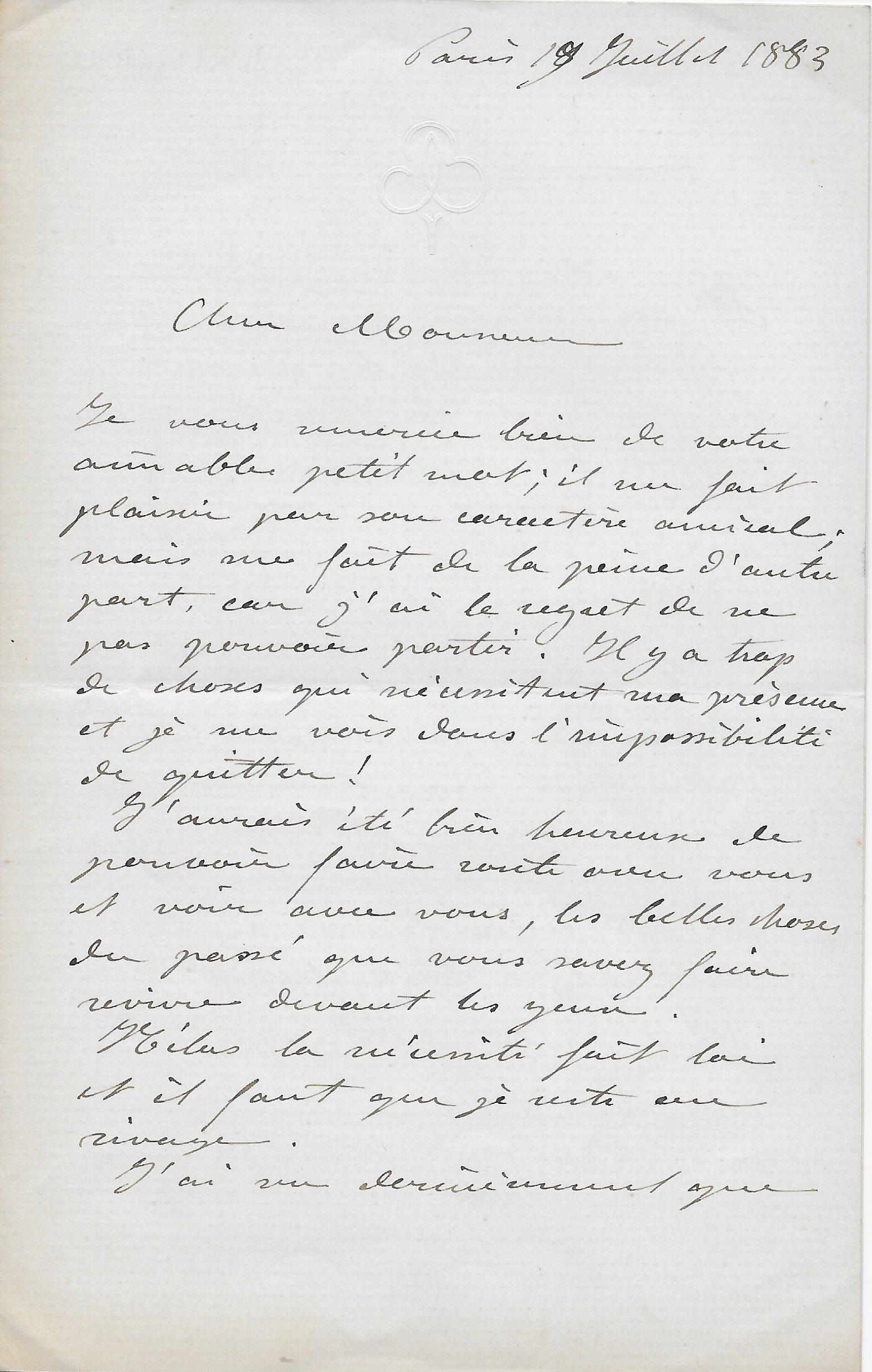Auguste BARTHOLDI - Statue of Liberty - Autograph letter signed
Frédéric Auguste BARTHOLDI (1834 - 1904), French sculptor
Autograph letter signed to the politician Henri Martin. Paris, July 19, 1883; 2 octavo pages.
Beautiful letter from the young sculptor Auguste Bartholdi, totally devoted to the colossal construction site of the Statue of Liberty, present on all fronts, including the promotion of his work: "I thank you very much for your kind little note; it pleases me by its friendly nature; but it also pains me, because I regret not being able to leave! There are too many things that require my presence and I find it impossible to leave! I would have been very happy to be able to travel with you and see with you, the beautiful things of the past that you know how to bring back to life before our eyes. Alas, necessity is the law and I must remain on the shore. I recently saw that you were in contact with the Hungarian travelers' society. If you would like to send them to see the Statue of Liberty, I am sending you enclosed an invitation card that you could address to them, if necessary I would go and receive them, if I am notified of the day and time. Perhaps this would not be bad for the moral character of our work (…)"
The Statue of Liberty project was born on April 21, 1865, when Edouard de Laboulaye, a law professor at the Collège de France and admirer of the young American democracy, suggested that France offer the United States a statue symbolizing Liberty Enlightening the World, thus sealing the friendship between the two countries. The design came from the young Auguste Bartholdi, distinguished by the creation of his colossal Lion of Belfort. France's defeat at Sedan, followed by the Paris Commune, and the political and financial problems encountered, delayed the project for ten years.
The statue was to be inaugurated on the centennial of the independence of the United States, July 4, 1876, but construction had barely begun at the Gaget-Gauthier & Cie foundry in the 17th arrondissement of Paris. Auguste Bartholdi was said to have been inspired by his dear mother's features for the statue's face, while the torch was to be made by Eugène Viollet-le-Duc. Financing it was a real obstacle course, with the appeal for American and French donations being essential. The hand was then presented at the Philadelphia World's Fair in 1876 and the head admired on the Champ de Mars during the 1878 exhibition. Gustave Eiffel, a brilliant designer of iron bridges, was chosen to build the iron frame of the Lady. The 46-meter-high building was completed in July 1884. Bartholdi, traveling in New York, had chosen the small island of Belloe's Island to house his masterpiece. It was dismantled piece by piece and transported by boat to Le Havre on May 21, 1885. It triumphantly entered New York Harbor on June 17. Erected on its metal base designed by Gustave Eiffel, it could finally illuminate the world from a height of 93 meters. The inauguration took place on October 28, 1886, in the presence of American President Grover Cleveland and Auguste Bartholdi.
Autograph letter signed to the politician Henri Martin. Paris, July 19, 1883; 2 octavo pages.
Beautiful letter from the young sculptor Auguste Bartholdi, totally devoted to the colossal construction site of the Statue of Liberty, present on all fronts, including the promotion of his work: "I thank you very much for your kind little note; it pleases me by its friendly nature; but it also pains me, because I regret not being able to leave! There are too many things that require my presence and I find it impossible to leave! I would have been very happy to be able to travel with you and see with you, the beautiful things of the past that you know how to bring back to life before our eyes. Alas, necessity is the law and I must remain on the shore. I recently saw that you were in contact with the Hungarian travelers' society. If you would like to send them to see the Statue of Liberty, I am sending you enclosed an invitation card that you could address to them, if necessary I would go and receive them, if I am notified of the day and time. Perhaps this would not be bad for the moral character of our work (…)"
The Statue of Liberty project was born on April 21, 1865, when Edouard de Laboulaye, a law professor at the Collège de France and admirer of the young American democracy, suggested that France offer the United States a statue symbolizing Liberty Enlightening the World, thus sealing the friendship between the two countries. The design came from the young Auguste Bartholdi, distinguished by the creation of his colossal Lion of Belfort. France's defeat at Sedan, followed by the Paris Commune, and the political and financial problems encountered, delayed the project for ten years.
The statue was to be inaugurated on the centennial of the independence of the United States, July 4, 1876, but construction had barely begun at the Gaget-Gauthier & Cie foundry in the 17th arrondissement of Paris. Auguste Bartholdi was said to have been inspired by his dear mother's features for the statue's face, while the torch was to be made by Eugène Viollet-le-Duc. Financing it was a real obstacle course, with the appeal for American and French donations being essential. The hand was then presented at the Philadelphia World's Fair in 1876 and the head admired on the Champ de Mars during the 1878 exhibition. Gustave Eiffel, a brilliant designer of iron bridges, was chosen to build the iron frame of the Lady. The 46-meter-high building was completed in July 1884. Bartholdi, traveling in New York, had chosen the small island of Belloe's Island to house his masterpiece. It was dismantled piece by piece and transported by boat to Le Havre on May 21, 1885. It triumphantly entered New York Harbor on June 17. Erected on its metal base designed by Gustave Eiffel, it could finally illuminate the world from a height of 93 meters. The inauguration took place on October 28, 1886, in the presence of American President Grover Cleveland and Auguste Bartholdi.
This description has been translated automatically. please click here Click here to display the original language FR
This item is sold by a professional art dealer who guaranties its authenticity. This item is used (second-hand)
For sale
Price :
1800 € Incl. VAT
Premium and Taxes included
Delivery France:
30.00 € incl. VAT (*)
Country prices, click on See
See more
Hotline
Please contact us for any question regarding this object. For any other inquiry, we invite you to fill the contact form.
Other items from the category « lettre »





